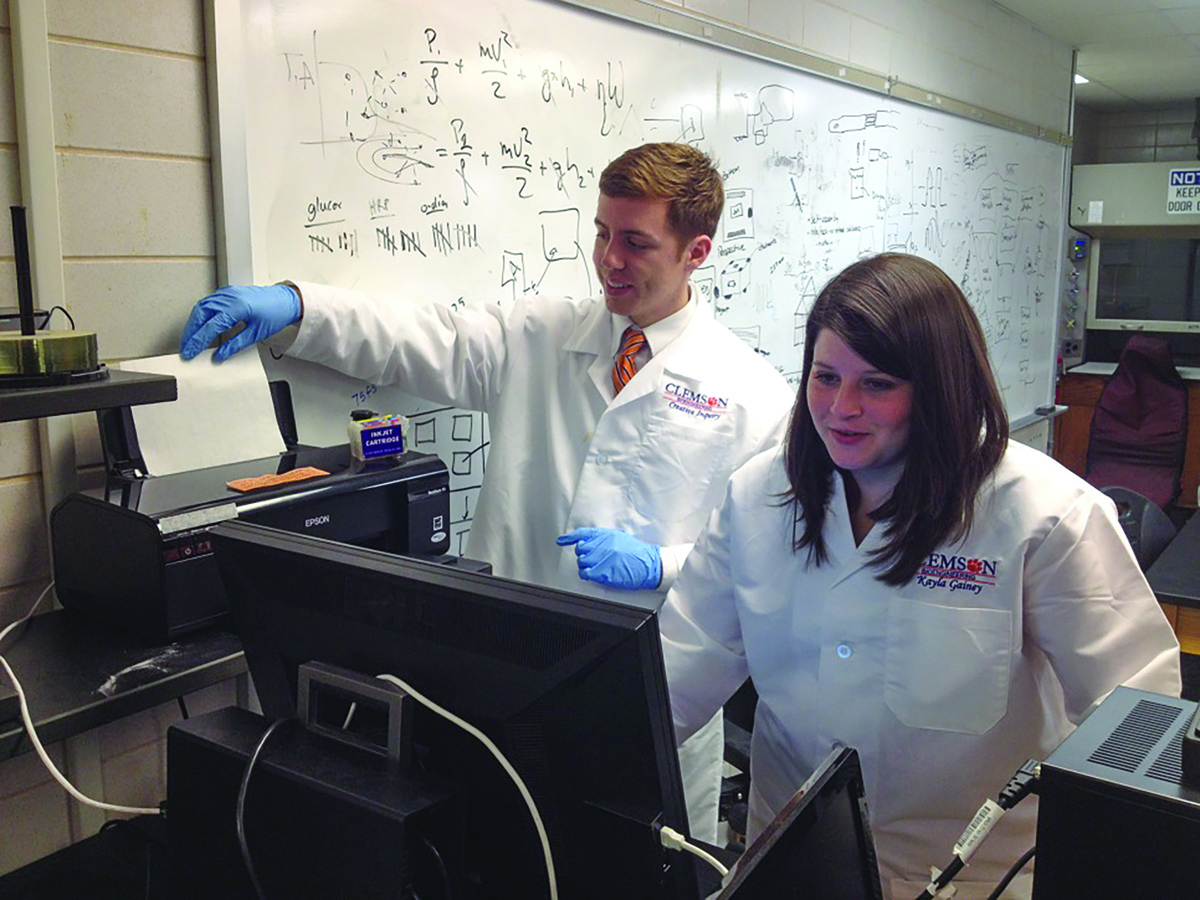the good sense of Glucosense
by Rachel Wasylyk

Tyler Ovington and Kayla Gainey print test strips in the laboratory. Photo by Paul Alongi.
A team creates low-cost testing for diabetics in need.
Twelve dollars. That’s the entire monthly household income for more than 25 percent of the families living in Tanzania. And the traditional cost of diabetes testing supplies per month? $120. According to the World Health Organization, 347 million people worldwide suffer from diabetes, and more than 80 percent of them are living in low- and middle-income countries.
To control their blood sugar levels, diabetics typically use test strips to check their glucose levels multiple times a day. Unfortunately, each test strip can be used only once. Low-income patients can’t afford strips at market prices, and they rely heavily on donated supplies. But donated strips are rarely compatible with the donated machines. And since test strips are temperature sensitive, they are often not usable after being shipped.
Developing a solution
A team of researchers at Clemson set out to solve the problem. They wanted to make testing devices both cheaper and more easily accessible by finding a way to print test strips for pennies.
First, the team developed working test strips that could be manufactured on an ordinary inkjet printer. Because standard filter paper could easily tear and contaminate the meter, the researchers used contact paper to reinforce and protect the filter paper.
Each paper receives three solutions, printed on the strip in layers: enzyme one, enzyme two, and the dye. A separate ink cartridge is used for each solution, and the team can easily specify the amount of enzyme deposited on the paper. Every strip contains both a control side, which does not receive the enzyme one solution, as well as an experimental side, which receives all three solutions. The glucose in blood reacts with the glucose oxidase in solution one, causing the enzymes to turn the paper blue. The more glucose present, the darker the paper will be after the reaction.
The researchers found a relationship between the glucose concentration in blood and the amount of light absorbed by the strip. More glucose leads to a darker solution, absorbing more light. Using a simple meter, the team shines LED lights above the strip, while photodetectors below measure how much light passes through. The machine can then calculate the glucose level in the blood.
Real-world application
The testing system, called Glucosense, includes a printer, a set of cartridges, blank test-strip paper, and ingredients in powder form for greater shelf life. The distributer then simply adds water, and approximately four thousand strips can be printed per cartridge at a hospital, clinic, or pharmacy.
Kayla Gainey, one of the lead students on the Glucosense project, has been a diabetic since the age of two, and she can’t imagine having to regulate her blood sugar levels without a monitor. “I don’t believe that just because someone is born in a place where there are no basic treatment options means they have to go without,” Gainey says. “We’re working in Tanzania right now, but think about how many other countries need this, as well.”
A start-up company, Accessible Diagnostics, LLC, was formed to bring Glucosense to the market. The members, Delphine Dean, Kayla Gainey, John Warner, and Brian McSharry, are working on production-level prototypes through collaboration with Sealevel Systems. They will use the machines to pursue FDA approval. Their goal is to get Glucosense to patients abroad as well as low-income diabetics in the U.S.
Glucosense recently won first place in the South Carolina Bio Pitch Contest, the Lemelson-MIT “Cure It!” Student Prize for undergraduates, as well as the bronze student-authored abstract award from the Diabetes Technology Society. This research was made possible by Clemson Creative Inquiry, Madaktari Africa, EWH, and the National Science Foundation NSF RII-EPS 0903795. Its contents are solely the responsibility of the authors and do not necessarily represent the official views of the NSF.
Delphine Dean is a professor of bioengineering in the College of Engineering and Science. Rachel Wasylyk, a 2012 graduate and former editor of Decipher, a student-led research magazine at Clemson, is now a marketing manager and freelance writer based in Charlotte, North Carolina.


